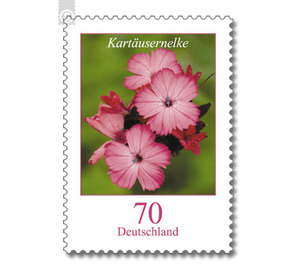Postal stamps: flowers - Germany / Federal Republic of Germany 2009 - 70 Euro Cent
Theme: Flora
| Country | Germany / Federal Republic of Germany |
| Issue Date | 2009 |
| Face Value | 70.00 |
| Perforation | S 14 |
| Printing Type | offset |
| Stamp Type | Postage stamp |
| Item Type | Stamp |
| Chronological Issue Number | 2589 |
| Chronological Chapter | GER-BRD |
| SID | 468975 |
| In 40 Wishlists | |
The Kartäuserelke is a mostly between 15 and 40 inches high growing perennial. Its leaves are bluish green, narrow and pointed. The pink to bright purple blooms of the Kartäuserelke enrich the color palette of sunny slopes, rocky dry grasslands and heath and karst meadows. They can even be found in mountainous regions up to 2,500 meters above sea level. The flowering period extends from July to September. Many of their natural habitats in Western Europe have been affected and destroyed by cultural measures, overgrazing or bush encroachment. Therefore, the Kartäuserelke is on the Red List of endangered animal and plant species. Its botanical name "Dianthus carthusianorum" consists of two names: "Dianthus" is derived from the Greek "Diosanthos", which means Zeus flower. The species name "carthusianorum" indicates the use of plants in monastery gardens, especially the Carthusian order. It has been cultivated since the 16th century, as its healing power was valued. Their crushed flowers were used, inter alia, against snake bites. The juice of the plant should help against pestilence and worms. It was once believed that the Karthauseelke lightning bolts. This brought her name as "Donnerelfelke", "Blitzblümchen" and "Einschlögnechala" (Einschlagnelke). Today it is mainly used as an ornamental plant.


